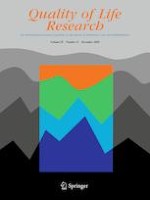26-08-2020
EQ-5D-3L health status and health state utilities of the oldest-old (85 +) in Germany: results from the AgeCoDe-AgeQualiDe study
Gepubliceerd in: Quality of Life Research | Uitgave 12/2020
Log in om toegang te krijgenAbstract
Purpose
To describe health status and health state utilities measured by the EQ-5D-3L in a population-based sample of individuals aged 85 + in Germany, and to analyze associations with basic socio-demographic variables.
Methods
Cross-sectional data from follow-up wave 7 (n = 761) of the German AgeCoDe Study were used. The EQ-5D-3L questionnaire was used to record problems in five health dimensions, its visual analogue scale (EQ VAS) was used to record self-rated health status, and the German EQ-5D-3L index was used to derive health state utilities.
Results
Mean age of respondents was 88.9 years (SD 2.9; range 85 to 100), 67.4% were female. 81.9% reported problems in at least one of the EQ-5D dimensions, with 15.3% reporting extreme problems. Most frequent were problems with pain/discomfort (64.8%), followed by mobility (62.5%), usual activities (42.6%), self-care (28.2%), and anxiety/depression (20.5%). Mean EQ VAS score was 62.4 (SD 18.8), and mean EQ-5D index was 0.77 (SD 0.24). Multiple regression analysis showed associations of problem frequency in various EQ-5D dimensions with age, gender, living situation, marital status, and education. The EQ VAS score was negatively associated with age (β = − 0.56; p < 0.05) and female gender (β = − 3.49; p < 0.05). The EQ-5D index was negatively associated with not living in the community (β = − 0.10; p < 0.001) and being single (β = − 0.09; p < 0.05).
Conclusions
The results show a substantially impaired health status of the oldest-old population. The data can be used for comparing health status of population groups as well as for health economic models.
